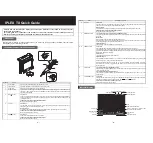
3
III.
EXPRESSION SHOE (Volume Control Pedal)
The organ’s expression pedal (called a “shoe”) is used to control the organ’s volume
(expression).
IV.
SETTING CAPTURE REGISTRATIONS
SETTING GENERAL PISTONS
Your Allen organ’s capture system lets you set stop registration combinations in each of its
available capture memories. The Historique III™ has a set of twelve (12) General pistons
centrally located under the Swell and Great manuals.
First, select the stops you wish to save.
Press and hold the
SET
Piston.
Press and release the desired GENERAL piston.
Finally, release the
SET
Piston.
Remember, General pistons are customarily set from soft to loud using graduated stop
combinations. The pistons you have set “remember” the registration combinations that you have
assigned to each of them. Each time a General piston is pressed, the registration assigned to it is
activated. You can change stop registration combinations at any time by repeating the above
procedure.
V. ARTISTIC
REGISTRATION
(Trained organists might not need to review this section.)
Organ registrations fall into two broad categories;
solo combinations
and
ensembles
. A solo
combination is one in which a melody is played on one keyboard, the accompaniment on another
keyboard. The pedal often provides a light bass line. Almost any stop or combination of stops
will sound good as a solo voice. A contrasting tone quality should be chosen for the
accompaniment, so that the accompaniment is softer than the solo voice. The Pedal stops must
provide a foundation for the solo and accompaniment without covering them.
Most 8’ reed stops make interesting solo voices. The addition of a 4’ flute or a flute mutation
(e.g., Nasard or Tierce) to a reed such as the Trompette colors the sound further and increases its
volume slightly. Adding an 8’ flute to a reed adds body to the sound.
Flutes can be used alone or in combinations as solo voices. One special combination of flutes
that creates an appealing and historically significant solo combination is the Cornet (pronounced
kor-NAY). The Cornet is created by using the following Swell stops: Gedackt 8’, Koppelflöte
4’, Nasard 2-2/3’, Blockflöte 2’ and Tierce 1-3/5’. This solo combination, widely used for
Baroque organ music, is just as appropriate for some modern music. Useful variations of the
Cornet may be achieved by eliminating the 4’, the 2’, or even both.
When choosing stops for a solo voice, it is not always necessary to include an 8’ stop; for
example, since the 4’ flute has a tone quality different from that of the 8’ flute, the 4’ flute can be
used as an independent solo voice. By playing a solo voice an octave lower than written, the
notes sound at the correct pitch. In similar fashion, a 16’ stop can be selected and the notes
played an octave higher than written. Tonal variety is gained, because each stop has its own tone
color.






































